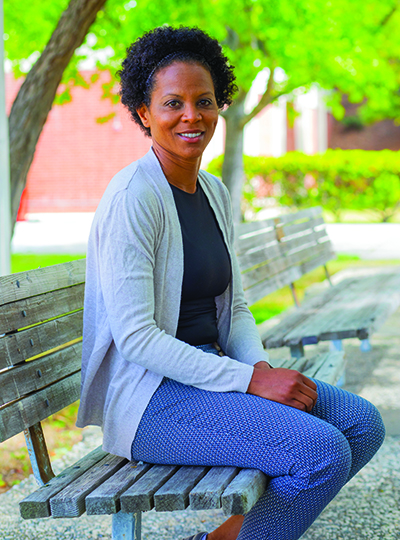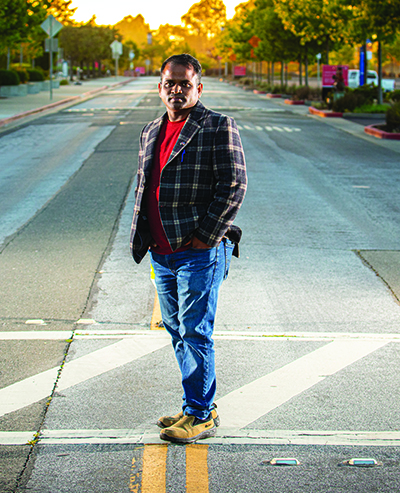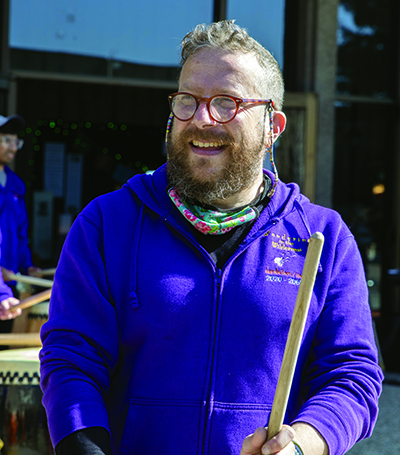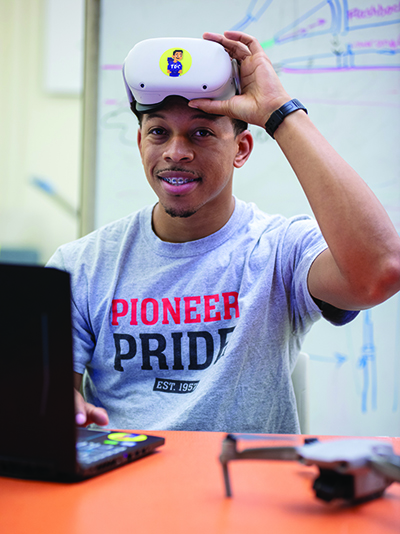
Driven to Change the Bias Narrative
BY Natalie Feulner
June 30, 2022
Cal State East Bay is a place of do-ers. A university where challenges present the opportunity for change. Where students in labs discover not only scientific breakthroughs but opportunities to improve their communities and the world.
After two years of living with constant change, spearheaded by a global pandemic — and, significantly, the rise of civil activism after hate against Asian Americans and the deaths of unarmed Black citizens — students, faculty and alumni are leading in areas of antiracist education, inclusivity, language development and social justice. As advocates at the local, state and national levels, they are re-educating educators and redefining the meaning of inclusive performance.
These are the changemakers of Cal State East Bay.
Andrea Johnson
Self-Reflection Drives Change
Andrea Johnson is a coach and personal trainer. A professor and a student. A mother and an advocate. And that’s never been more true than in the last two years since the murder of George Floyd and the subsequent email sent to families from her childrens’ school.
 “I responded to the principal sharing that I believed we needed more than that, we needed healing spaces,” Johnson says. “We needed to give a voice to the Black community at our school, and we need to let that voice come out.”
“I responded to the principal sharing that I believed we needed more than that, we needed healing spaces,” Johnson says. “We needed to give a voice to the Black community at our school, and we need to let that voice come out.”
Soon after, the school came together on Zoom, and many students, teachers and families began sharing their experiences. Since then, Johnson’s work with the school has grown to include professional development for teachers and supporting the equity team. Through her program, teachers have completed training around equity, bias, creating more inclusive policies, and incorporating what they’re learning into their work in the classroom.
“We’ve continued on,” Johnson says. “We went on to look at unconscious bias among white individuals and what the issues are that we need to be aware of.”
Johnson’s days are busy as a mother, a professor, and a student in Cal State East Bay’s Doctoral Program in Educational Leadership for Social Justice. But she is buoyed by the knowledge that opportunities come from stepping out of her comfort zone.
“I started first with my own reflection and journey and began realizing that I needed to do more,” Johnson says. “I think the key to transformative change is figuring out what piece you can play.
Sometimes it can feel daunting, but you have to continue working, you have to be willing to take the steps, to do the hard work and to know that change isn’t easy, but someone has to do it.”
She says the work she’s done with Oakland public schools has not only been transformative to her community but also intersects with her work at Cal State East Bay.
“Any time you work with people, you have to be aware of where they come from and be open-minded to seeing beyond your reality and your world,” Johnson says. “Students come from all walks of life, and we have to meet them where they are and have conversations that show you’re willing to see their side of things. No matter what your work is, you can’t fully understand others unless you can look beyond yourself.”
Asked to share her advice with people who are striving for a more equitable future, Johnson noted that it’s a journey that starts from within.
“Self-reflection is first,” she says. “You can’t get anywhere if you refuse to look at yourself first. And get comfortable with being uncomfortable. Sit with that discomfort and then continue to change. Continue to look at things in a new light because that’s when progress happens.”
Prem Pariyar
Fighting Caste Discrimination
 Several years ago in his native Nepal, Cal State East Bay alumnus Prem Pariyar’s family was brutally attacked. Pariyar and his family are Dalit, a group of people once known as “untouchables” in South Asia’s caste hierarchy, which infiltrates everything from day-to-day life to politics.
Several years ago in his native Nepal, Cal State East Bay alumnus Prem Pariyar’s family was brutally attacked. Pariyar and his family are Dalit, a group of people once known as “untouchables” in South Asia’s caste hierarchy, which infiltrates everything from day-to-day life to politics.
Against the wishes of some, Pariyar ’21 (MSW), an associate mental health clinician, went to the local authorities in a search for justice but instead found himself targeted and told to keep silent.
“Every day, the marginalized in Nepal experienced discrimination, every day, so this was not new,” he says. “But my dad, my mom and my sister, they were hospitalized. How could I remain silent?” he says.
Fortunately, Pariyar received a U.S. visa and moved to the Bay Area in 2015. When he arrived, he remembers thinking, “I’m in a safe place. People are aware of human rights, people are educated, so people must not discriminate based on caste identity.”
He soon learned, however, that caste discrimination not only existed in the U.S., but it was also absent from the categories often included in anti-discrimination policies.
He recalls a friend from a dominant caste asking him to attend a house party, but after Pariyar shared his surname, the hosts grew noticeably uncomfortable. They refused to let him serve his own food or eat with the rest of the guests and continued to shun him.
“I was speechless and embarrassed, but I could not say anything because I was new here,” Pariyar says. “At the time, I stayed quiet, but I had so many questions in my mind. These are people who are in the U.S. but their mindset is traditional. Their mindset has not changed.”
Since that fateful party, Pariyar has worked every day to advocate for others like him, a journey that ultimately led to the CSU system adding caste to its nondiscrimination policy, effectively prohibiting caste-based bias at all 23 campuses.
“I never found that word in anything we were learning, but this type of discrimination has the longest history, more than 1,000 years of history. Still, it wasn’t in any textbook or conversation,” he says. “I knew my classes were the right place to start talking about it because, as social workers, we are here to learn how to be fighters for justice.”
Since Jan. 1, when the CSU adopted its new policy, Pariyar has toured the state and country, talking with other universities and nonprofits about including caste discrimination as a specific category in policies.
He says he’s not stopping his work any time soon.
“If we are going to fight for all kinds of ‘isms,’ then we need to understand caste, because of all of these social issues, of these types of social categories like gender, race and sexuality, their base is caste,” he says.
Eric Kupers
Dance Chair Promotes Inclusivity
For Cal State East Bay professor Eric Kupers, performance is an opportunity for the complexities of life to be explored. All of them — not merely what is beautiful and pleasing.
 In Kupers’ classroom, that means exploring and encouraging a world of dance where everyone can show up and share their story, celebrating our differences of race, gender, disability/ability, size, shape and neurotype. With that core value, the look and feel of every program is unpredictable and constantly evolving.
In Kupers’ classroom, that means exploring and encouraging a world of dance where everyone can show up and share their story, celebrating our differences of race, gender, disability/ability, size, shape and neurotype. With that core value, the look and feel of every program is unpredictable and constantly evolving.
Kupers calls it ‘inclusive performance.’
“Inclusive performance for me is a way of approaching creativity and community in which we are always being very attentive to who is in the room and what are people’s needs and what are people’s gifts … and there’s this creative puzzle of how we get through it together,” Kupers says.
Since starting at Cal State East Bay more than 20 years ago, Kupers has long attracted students with divergent ways of thinking, bodies and lived experiences. Their work has varied in form from a wheelchair ballroom dancing class to a Creativity Lab where neurodivergent participants explore visual art, music, storytelling and more.
During the past couple of years, Kupers says more and more people, students and community members alike, have wanted to incorporate social justice activism into all aspects of life, especially the arts.
“We see modern dance and performance as vehicles for social change,” Kupers says.
And the pandemic, by nature, has provided an opportunity to explore adaptation, something central to all of Kupers’ work long before COVID entered the collective lexicon.
“Part of my goal in our department has been to support projects and programs that are geared toward adaptation and flexibility,” Kupers says. “We had to move to Zoom, but that’s not any different from what we were doing in my classes before, even if it looks different from the physical forms we’re used to seeing.”
This fall, Kupers will bring back the university’s second annual Inclusive Performance Festival. The program will take place during October and November and explore how different artists, teachers and thinkers connect with their ancestors and the spirit world.
Kupers hopes it is an opportunity to turn the idea of what a performance should be or look like on its head, whether that’s moving portions to a virtual format or having the ‘performance’ take place during an everyday moment such as class.
“I think we need to ask for every project we do … what is the form that most fits this, who is performing, and who do we want to see involved,” Kupers says. “How can each thing we do have a clear intention and be serving us and our community at every stage so every rehearsal is a kind of performance and every performance is a kind of rehearsal.”
Devin Baldwin
Scientist Drives STEM For Kids
 Devin Baldwin is a serious Star Wars nerd.
Devin Baldwin is a serious Star Wars nerd.
But it’s that passion, with a healthy dose of “LEGO mania,” that has led him to pursue a degree in computer science and work to ensure that middle and high school students in the East Bay have every opportunity to do the same.
“I’m from LA but live in East Oakland and I play basketball at the parks and have met a lot of the kids of East Oakland,” Baldwin says. “They need guidance, they need something to do. There’s nothing else keeping them from doing the things that other people don’t want them to do.”
So, he teaches them.
In addition to being a full-time student and intern at Lawrence Berkeley National Laboratory, Baldwin is also a lead instructor at STEMTank, an organization working to prepare the next generation of technologists, innovators and entrepreneurs.
His classes are focused on WebXR, which stands for “Extended Reality.” Think augmented and virtual worlds that only require a web browser and can be used for everything from gaming to creating simulation modules for training employees or testing operating systems.
“I was contracted by STEMTank to build a WebXR curriculum and teach the students the material and it was my first experience as a lead instructor,” Baldwin says. “But I grew up raising a lot of my younger siblings, so I know how to appeal to kids. I wasn’t scared.”
As an older student at Cal State East Bay — he’s 27 — Baldwin also often finds himself in a mentorship role among peers. He took somewhat of a nontraditional route to higher education. He transferred to East Bay with his associate’s degree in computer programming from Laney College and has held jobs at several Bay Area tech companies. But now, he says, he has a perspective that helps him in and outside the classroom.
“First, I like that East Bay actually takes the time to curate the courses that will reflect what you’ll actually be doing in the field,” Baldwin says. “But another thing I’ve noticed as an older student is that there’s a benefit to me sharing my experience. They think there is this expectation of perfection and I just let them know to focus on what you can do and be yourself.”
As for what’s next, Baldwin has his eyes set on continuing to help students within his community find a role for themselves in tech and see a future they may not have even imagined for themselves.
“I’m welcoming them into a space where they have the opportunity to really change and augment their current reality,” Baldwin says. “I tell them, ‘Your current reality may not be the most ideal for you and I know that’s a lot to deal with. But when you come here, you have the opportunity, the space and permission to be yourself and to create the reality you see for yourself.’”
Share this story